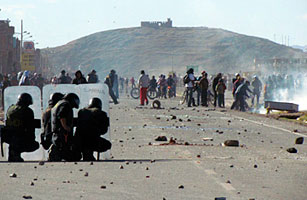
If the past few days are any indication of things to come, Peru’s President-elect Ollanta Humala is in for a rough ride when he takes office on July 28. On Saturday, indigenous protesters in the country’s southeast radically upped the stakes in their nearly seven-week campaign against the government’s mining and oil/gas policies by taking over an airport in Juliaca, the business hub of the Puno department. Five protesters were killed by the police the previous day in an earlier attempt to take the airport. The losses from the series of strikes and shut-downs is estimated at close to $100 million and, apart from the violence, are sending shudders through an economy already nervous about Humala’s left-leaning proclivities. Indeed, the controversy has become more than a quarrel about a single project but has come to symbolize a larger debate about development in Peru.
“The government allowed this problem to grow from opposition to a mining project to opposition to mining and hydrocarbons in general,” says Rolando Luque, of the Peruvian government’s human rights ombudsman’s office.
Luque says such conflicts will likely increase when Humala takes office, with Peruvians expecting him to make good on campaign promises to better distribute the wealth generated by the country’s decade-long economic boom. “We are talking about economic growth between 6% and 10% annually for the past few years, which has created expectation in the population,” says Luque. “These expectations are likely to increase, forcing the state to be more representative and effective when it comes to how resources are used.”
The protests in Puno began in early May in a few towns bordering Lake Titicaca, the world’s highest navigable lake, which Peru’s shares with neighboring Bolivia. The initial demand was for the cancellation of a mining concession granted in 2007 to Canada’s Bear Creek Mining. Protesters blocked the bordering crossing with Bolivia and other highways. The government of incumbent President Alan Garca began responding only after the first flare-up of violence in late May, when protesters set fire to several government buildings and threatened to disrupt the June 5 presidential elections that Humala eventually won.
The Garca government offered to partially meet the demands of the indigenous protesters and environmental activists, announcing that it would suspend mining concessions for 12 months. Protests leaders, however, rejected the offer and re-erected roadblocks on June 7, insisting on the elimination of Bear Creek’s permit. The strike then spread from the four provinces around Lake Titicaca to the whole of Puno department, affecting other industries as well. “We have been clear from the start that we want this concession, which was illegally awarded, to be withdrawn,” Walter Aduviri, head of the environmental front that led the initial strike, told TIME in a telephone interview prior to the violent incident at the airport.
The government finally decided to rescind the Bear Creek concession on June 24, but the move came just as 4,000 protesters were already marching on the Juliaca airport. Police officers fired on the protesters when they tried to take over the runway. Thousands returned to the airport the following day, taking over the terminal and occupying the runway. Protest leaders have not indicated whether they plan on lifting the strike, but demonstrators had left the Juliaca airport by Sunday morning and there were no reports of protests in other areas of Puno.
President Garca on Saturday said there were “dark political interests” behind the protests that want to pressure Humala, who is just now beginning to form his Cabinet and the roadmap he will follow in his five-year term.
Humala, for his part, has refused demands from members of Garca’s APRA party that he get involved in the conflict. “I call on the central government and leaders in Puno to put aside violent actions and look for a peaceful solution,” Humala said on Saturday even as he refused to get into the direct negotiations with any party in the Puno conflict. Most analysts agree that any solution reached between the Garca government and the protesters will likely be temporary; and that Humala will inherit the mess upon his inauguration, facing intense pressure not only from the protesters but from corporations, both local and global, with huge investments in Peru.
The government and mining and oil/gas companies estimate that there will be more than $50 billion in investment in new projects in the coming 10 years. Bear Creek is not the only company to be adversely affected by protests. In April, the government revoked the concession for a $950-million copper project being developed by Southern Copper Corporation. That move came after four people were killed in clashes with police officers. Last week, the Garca government also cancelled a $4-billion hydroelectric plant that would have been built in Puno’s Carabaya province.
Meanwhile, according to Luque’s office, nearly 100 protesters have been killed past three years in clashes with police officers, including 24 police officers and 10 indigenous protesters killed during a clash on June 5, 2009. The ombudsman’s office catalogued 227 local protest movements in May, with Puno in second place nationally with 21 such conflicts. Hernando de Soto, Peru’s best known economist, told TIME in an interview several weeks earlier that his Democracy and Liberty Institute estimates around 1,000 social conflicts simmering in the country.
See the 25 best blogs of 2011.
See the world’s most influential people in the 2011 TIME 100.